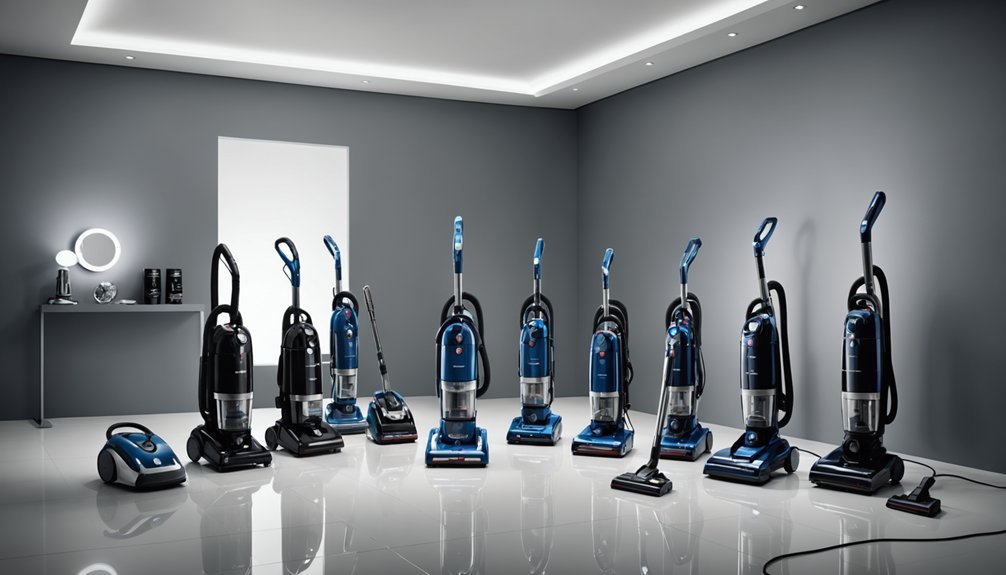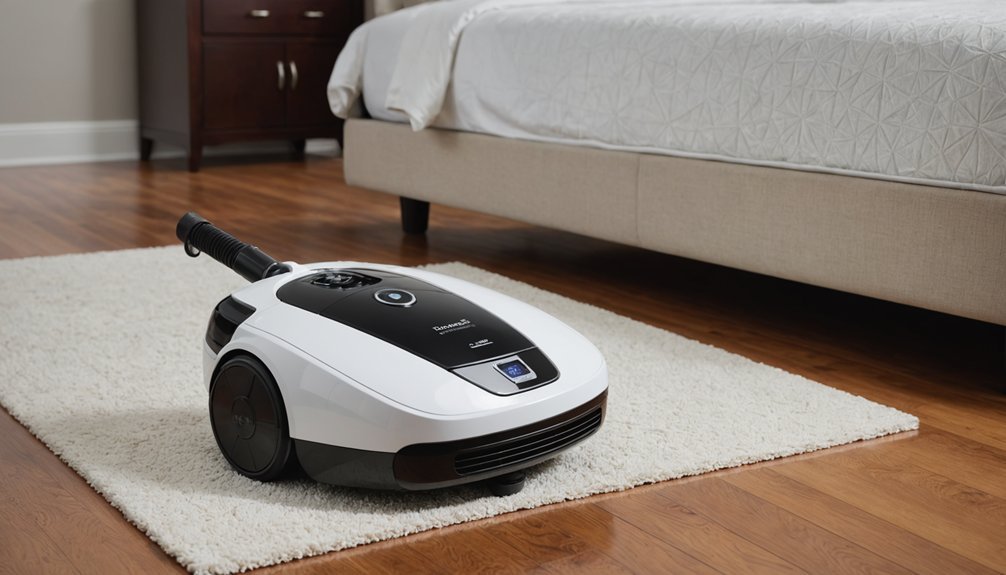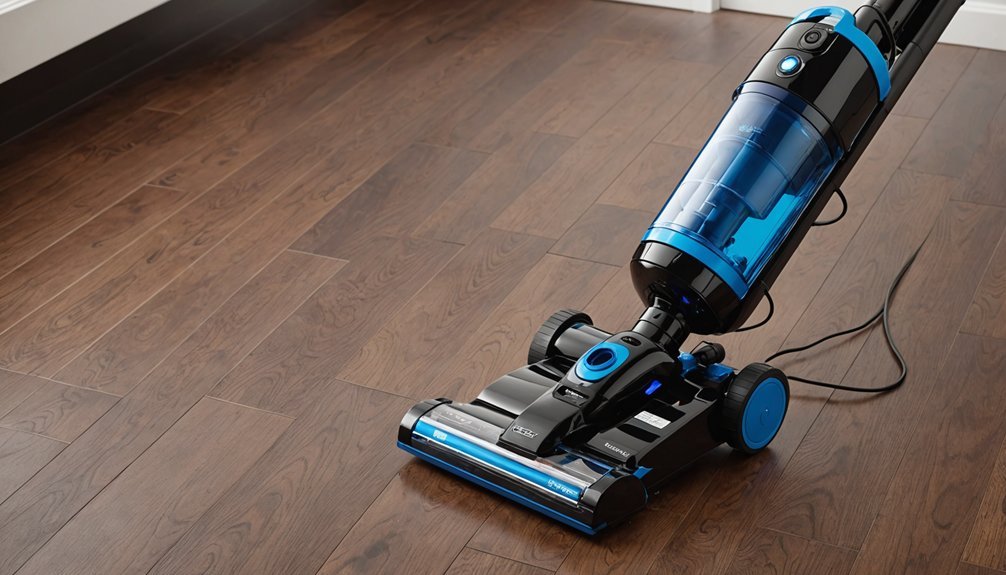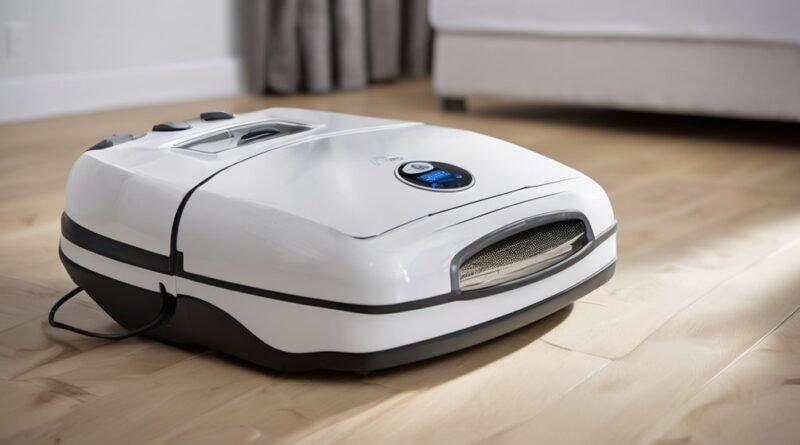Best Vacuum Cleaners for Bed Bug Control
If you’re battling bed bugs, you’ll need more than just any vacuum cleaner to win the fight. These resilient pests require specific suction power, filtration systems, and specialized attachments to guarantee effective removal and prevent re-infestation. While standard vacuums might seem adequate, they often fall short in essential areas that make the difference between temporary relief and lasting control. Let’s explore what makes certain vacuum cleaners excel at bed bug elimination.
Key Takeaways
- Choose vacuums with minimum 60 CFM suction power and 480W motors to effectively extract bed bugs and eggs from surfaces.
- HEPA filtration with sealed systems is essential to prevent bed bugs from escaping during cleaning and disposal.
- Look for models with specialized attachments like crevice tools and narrow nozzles to reach deep into cracks and crevices.
- UV-C light technology combined with strong suction provides dual-action effectiveness by killing bugs while removing them.
- Select vacuums with wide suction ports (240mm) and rotating brushes to maximize cleaning coverage and dislodge embedded pests.
Understanding Vacuum Suction Power Requirements for Bed Bug Removal

Vacuum suction power plays a critical role in effective bed bug removal. You’ll need a vacuum with strong enough suction to extract both live bugs and their eggs from deep within cracks, seams, and crevices where they hide.
Since bed bug eggs are sticky and only about 1mm in size, low or moderate suction simply won’t cut it. Regular repeated vacuuming sessions will be necessary over several weeks for best results. To guarantee thorough removal, you’ll want a vacuum with high airflow (CFM) ratings and a powerful motor specifically designed for pest control.
Look for models featuring HEPA filtration to prevent tiny particles from escaping during vacuuming. It’s also essential to have the right attachments, like crevice tools and brushes, to concentrate suction power into microscopic spaces.
Remember that suction alone won’t kill bed bugs – it’s just one part of an integrated pest control strategy.
Essential Filtration Features for Safe Bed Bug Extraction

When battling bed bugs, proper filtration is essential for both effective removal and preventing escaped pests. You’ll want a vacuum with HEPA filtration that captures 99.97% of particles down to 0.3 microns, ensuring bed bugs and their eggs stay trapped. Look for completely sealed systems with secure cartridge filters or synthetic bags that prevent any escape. Models like the JIGOO demonstrate effectiveness with LED display feedback during operation.
| Feature | Why It Matters |
|---|---|
| HEPA Filtration | Traps 99.97% of particles at 0.3 microns |
| Sealed System | Prevents bed bugs from escaping |
| UV-C Light | Kills bacteria and microorganisms |
| Heat Treatment | Maintains 120°F+ for pest mortality |
| Quick-Change Filters | Enables safe maintenance |
For maximum effectiveness, choose vacuums that combine HEPA filtration with secondary sanitizing technologies like UV-C light or heat treatment. These features work together to not only capture bed bugs but also neutralize them and their allergens.
Key Design Elements and Attachments for Thorough Cleaning

Effective bed bug removal demands specific design elements and attachments that work together to achieve thorough cleaning results.
You’ll need a vacuum with at least 60 CFM suction power and a motor between 480-500W to effectively extract bugs from surfaces. Look for models featuring wide suction ports around 240mm that boost cleaning efficiency.
Your vacuum should include specialized attachments like crevice tools and narrow nozzles to access hiding spots in mattress seams and furniture cracks. A reliable option like the Atrix Box Soccer comes with carpet attachments and tools specifically designed for thorough cleaning.
Consider units with rotating brushes that spin up to 12,000 RPM, as they’ll help dislodge deeply embedded bugs and eggs.
The best designs integrate heating elements that reach 140°F and UV light technology near suction zones, giving you enhanced pest elimination power without damaging fabrics.
Advanced Technologies in Modern Bed Bug Vacuums
Modern bed bug control has evolved far beyond simple suction power, incorporating cutting-edge technologies that make pest elimination more thorough and efficient.
You’ll find UV-C light technology that kills 99.9% of germs and bed bugs on contact, while ultrasonic vibrations shake loose deeply embedded pests and eggs at rates up to 15,000 vibrations per minute.
Today’s advanced vacuum systems combine powerful 12-16 kPa suction with HEPA filtration that captures 99.97% of microscopic particles. With triple filtration systems, these devices ensure comprehensive protection against ultrafine particles and allergens.
Many units also feature heat application and dehumidification to accelerate pest mortality.
For hands-free operation, smart robotic vacuums use advanced navigation systems to guarantee complete mattress coverage.
These technologies work together to create a multi-pronged approach, targeting bed bugs at every life stage while containing allergens and preventing reinfestation.
Top-Rated Vacuum Models for Bed Bug Elimination
Selecting a top-rated vacuum cleaner for bed bug control requires careful consideration of both corded and cordless options.
The Jimmy BX5 Pro-120V leads corded models with 14KPa suction power and HEPA filtration, while the MiteLipik excels in cordless convenience with its 1800mAh battery and lightweight design.
For thorough cleaning, you’ll find the Shark Navigator Lift-Away Deluxe NV360’s detachable canister especially useful for reaching under furniture. The Lift-Away technology allows effective portable cleaning while maintaining durability for regular use.
The Atrix VACBP1 HEPA Backpack Vacuum offers specialized bed bug attachments for complete mattress treatment.
Many models now feature UV-C light technology, which helps eliminate microbes while vacuuming.
Look for units with transparent collection chambers to monitor your progress and multi-stage filtration to prevent bed bugs from escaping back into your environment.
Critical Features to Consider When Choosing a Bed Bug Vacuum
When hunting for a bed bug vacuum, you’ll need to focus on five essential features that determine its effectiveness: suction power, filtration quality, attachment versatility, design practicality, and supplemental functions.
Look for models delivering at least 60 CFM with wide suction ports for thorough coverage. You’ll want a HEPA filtration system that’s properly sealed to trap 99.97% of particles and prevent bugs from escaping.
Choose a vacuum with specialized attachments like crevice tools and upholstery brushes to access tight spaces where bed bugs hide. Consider lightweight, cordless options with ergonomic designs for easy maneuverability during detailed cleaning.
Finally, evaluate additional features like UV-C light technology, steam cleaning capabilities, or humidity monitoring systems that can enhance your bed bug control efforts.
Effective Vacuum Usage and Maintenance Tips for Pest Control
Successful bed bug control through vacuuming requires both proper technique and diligent maintenance of your equipment.
Use crack-and-crevice attachments with high suction settings to target bugs in seams, folds, and hidden spaces. Cover the nozzle with tape when moving between areas to prevent spreading.
After each use, you’ll need to clean your vacuum thoroughly. Double-bag and seal the contents, then dispose of them outdoors.
For bagless models, wash canisters with hot soapy water and replace HEPA filters regularly. Clean all detachable parts and inspect for remaining bugs or eggs.
Remember that vacuuming works best as part of an integrated approach. While it’s effective at removing live bugs and debris, you’ll need additional treatment methods to fully eliminate an infestation.
Conclusion
You’ll find the right vacuum for bed bug control by focusing on high suction power, HEPA filtration, and specialized attachments. Don’t forget to contemplate models with UV-C technology and sealed systems for maximum effectiveness. Remember to maintain your vacuum properly and empty it carefully after each use. With these features and proper technique, you’re well-equipped to tackle bed bug infestations effectively.

